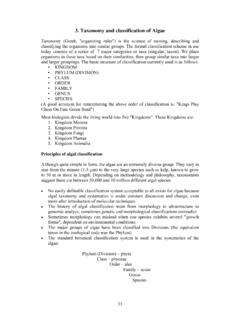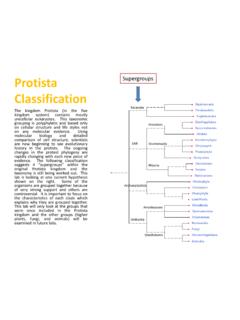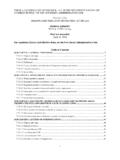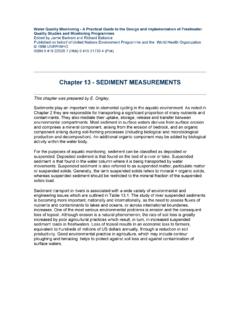Transcription of C 2 IOLOGICAL CLASSIFICATION
1 16 BIOLOGYS ince the dawn of civilisation, there have been many attempts to classifyliving organisms. It was done instinctively not using criteria that werescientific but borne out of a need to use organisms for our own use forfood, shelter and clothing. Aristotle was the earliest to attempt a morescientific basis for CLASSIFICATION . He used simple morphological charactersto classify plants into trees, shrubs and herbs. He also divided animalsinto two groups, those which had red blood and those that did Linnaeus' time a Two Kingdom system of CLASSIFICATION withPlantae and Animalia kingdoms was developed that included all plantsand animals respectively. This system was used till very recently. Thissystem did not distinguish between the eukaryotes and prokaryotes,unicellular and multicellular organisms and photosynthetic (green algae)and non-photosynthetic (fungi) organisms.
2 CLASSIFICATION of organismsinto plants and animals was easily done and was easy to understand,but, a large number of organisms did not fall into either category. Hencethe two kingdom CLASSIFICATION used for a long time was found need was also felt for including, besides gross morphology, othercharacteristics like cell structure, nature of wall, mode of nutrition, habitat,methods of reproduction, evolutionary relationships, etc. Classificationsystems for the living organisms have hence, undergone several changesover time. Though plant and animal kingdoms have been a constantunder all different systems, the understanding of what groups/organismsbe included under these kingdoms have been changing; the number andnature of other kingdoms have also been understood differently bydifferent scientists over CLASSIFICATIONCHAPTER , Viroidsand Lichens2015-16(19/01/2015)BIOLOGICAL Whittaker (1969) proposed a Five Kingdom kingdoms defined by him were named Monera, Protista, Fungi,Plantae and Animalia.
3 The main criteria for CLASSIFICATION used by himinclude cell structure, thallus organisation, mode of nutrition,reproduction and phylogenetic relationships. Table gives acomparative account of different characteristics of the five us look at this five kingdom CLASSIFICATION to understand the issuesand considerations that influenced the CLASSIFICATION system. Earlierclassification systems included bacteria, blue green algae, fungi, mosses,ferns, gymnosperms and the angiosperms under Plants . The characterthat unified this whole kingdom was that all the organisms included hada cell wall in their cells. This placed together groups which widely differedin other characteristics. It brought together the prokaryotic bacteria andthe blue green algae with other groups which were eukaryotic. It alsogrouped together the unicellular organisms and the multicellular ones,say, for example, Chlamydomonas and Spirogyra were placed togetherunder algae.
4 The CLASSIFICATION did not differentiate between theheterotrophic group fungi, and the autotrophic green plants, thoughthey also showed a characteristic difference in their walls composition the fungi had chitin in their walls while the green plants had a cellulosicFive KingdomsCharactersCell typeCell wallNuclearmembraneBodyorganisationMode ofnutritionMoneraProkaryoticNoncellulosi c(Polysaccharide+ amino acid)AbsentCellularAutotrophic(chemosyn- thetic andphotosynthetic)and Hetero-trophic (sapro-phytic/para-sitic)ProtistaEukaryo ticPresent insomePresentCellularAutotrophic(Photosy n-thetic) andHetero-trophicFungiEukaryoticPresent( withoutcellulose)PresentMulticeullar/loo se tissueHeterotrophic(Saprophytic/Parasiti c)PlantaeEukaryoticPresent(cellulose)Pre sentTissue/organAutotrophic(Photosyn-the tic)AnimaliaEukaryoticAbsentPresentTissu e/organ/organ systemHeterotrophic(Holozoic/Saprophytic etc.)
5 TABLE Characteristics of the Five Kingdoms2015-16(19/01/2015)18 BIOLOGY cell wall. When such characteristics were considered, the fungi were placedin a separate kingdom Kingdom Fungi. All prokaryotic organisms weregrouped together under Kingdom Monera and the unicellular eukaryoticorganisms were placed in Kingdom Protista. Kingdom Protista hasbrought together Chlamydomonas, Chlorella (earlier placed in Algaewithin Plants and both having cell walls) with Paramoecium and Amoeba(which were earlier placed in the animal kingdom which lack cell wall). Ithas put together organisms which, in earlier classifications, were placedin different kingdoms. This happened because the criteria for classificationchanged. This kind of changes will take place in future too depending onthe improvement in our understanding of characteristics and evolutionaryrelationships.
6 Over time, an attempt has been made to evolve aclassification system which reflects not only the morphological,physiological and reproductive similarities, but is also phylogenetic, ,is based on evolutionary this chapter we will study characteristics of Kingdoms Monera,Protista and Fungi of the Whittaker system of CLASSIFICATION . The KingdomsPlantae and Animalia, commonly referred to as plant and animalkingdoms, respectively, will be dealt with separately in chapters 3 and MONERAS poreFlagellumCocciBacilliSpirillaVibrioF igure Bacteria of different shapesBacteria are the sole members of the Kingdom Monera. They are the mostabundant micro-organisms. Bacteria occur almost everywhere. Hundredsof bacteria are present in a handful of soil. They also live in extreme habitatssuch as hot springs, deserts, snow and deep oceans where very few otherlife forms can survive.
7 Many of them live in or on other organisms are grouped under four categories based on their shape: thespherical Coccus (pl.: cocci), the rod-shaped Bacillus (pl.: bacilli), thecomma-shaped Vibrium (pl.: vibrio) and the spiral Spirillum (pl.: spirilla)(Figure ).2015-16(19/01/2015)BIOLOGICAL CLASSIFICATION19 Though the bacterial structure is very simple, they are very complexin behaviour. Compared to many other organisms, bacteria as a groupshow the most extensive metabolic diversity. Some of the bacteria areautotrophic, , they synthesise their own food from inorganic may be photosynthetic autotrophic or chemosynthetic vast majority of bacteria are heterotrophs, , they do not synthesisetheir own food but depend on other organisms or on dead organic matterfor bacteria are special since they live in some of the most harsh habitatssuch as extreme salty areas (halophiles), hot springs (thermoacidophiles)and marshy areas (methanogens).
8 Archaebacteria differ from other bacteriain having a different cell wall structure and this feature is responsible fortheir survival in extreme conditions. Methanogens are present in the gutof several ruminant animals such as cows and buffaloes and they areresponsible for the production of methane (biogas) from the dung of filamentous blue-greenalgae are thousands of different eubacteria or truebacteria . They are characterised by the presence of arigid cell wall, and if motile, a flagellum. Thecyanobacteria (also referred to as blue-green algae)have chlorophyll a similar to green plants and arephotosynthetic autotrophs (Figure ). Thecyanobacteria are unicellular, colonial or filamentous, freshwater /marine or terrestrial algae. The coloniesare generally surrounded by gelatinous sheath. Theyoften form blooms in polluted water bodies. Some ofthese organisms can fix atmospheric nitrogen inspecialised cells called heterocysts, , Nostoc andAnabaena.
9 Chemosynthetic autotrophic bacteriaoxidise various inorganic substances such asnitrates, nitrites and ammonia and use the releasedenergy for their ATP production. They play a great rolein recycling nutrients like nitrogen, phosphorous,iron and bacteria are the most abundantin nature. The majority are important of them have a significant impact on humanaffairs. They are helpful in making curd from milk,production of antibiotics, fixing nitrogen in legume2015-16(19/01/2015)20 BIOLOGY roots, etc. Some are pathogens causing damageto human beings, crops, farm animals and , typhoid, tetanus, citrus canker are wellknown diseases caused by different reproduce mainly by fission ( ). Sometimes, under unfavourable conditions,they produce spores. They also reproduce by asort of sexual reproduction by adopting aprimitive type of DNA transfer from one bacteriumto the Mycoplasma are organisms thatcompletely lack a cell wall.
10 They are the smallestliving cells known and can survive without oxygen. Many mycoplasmaare pathogenic in animals and PROTISTAAll single-celled eukaryotes are placed under Protista, but the boundariesof this kingdom are not well defined. What may be a photosyntheticprotistan to one biologist may be a plant to another. In this book weinclude Chrysophytes, Dinoflagellates, Euglenoids, Slime moulds andProtozoans under Protista. Members of Protista are primarily kingdom forms a link with the others dealing with plants, animalsand fungi. Being eukaryotes, the protistan cell body contains a well definednucleus and other membrane-bound organelles. Some have flagella orcilia. Protists reproduce asexually and sexually by a process involvingcell fusion and zygote group includes diatoms and golden algae (desmids). They are foundin fresh water as well as in marine environments.
















